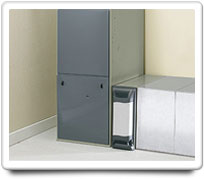Question Topic
Furnace (Gas) Draining The System/Purging And Refilling

POLICY-Wizard™ calculates your ideal home care program to avoid problems with your Furnace (gas), but sometimes trouble can still occur. Here are answers to questions about furnace (gas) draining the system/purging and refilling.
QUESTION FROM mjones61380
My husband and I like to fix things ourselves. We bought a new circulator for our fuel fired baseboard furnace. We know that we need to drain our system and shut off the water source but are unsure how to do this. We also will have to put water back in and get rid of air. Can you walk us through this or send us in the right direction? A how to guide? Electric portable heaters are fine for a little while but it sure is cold at our house!
Thanks
ANSWER FROM POLICY-Wizard™
Dear mjones61380:
Regarding a procedure draining, re-filling and purging air from your baseboard heating system, it will depend on your specific configuration of valves, etc. But in general, here is the procedure a baseboard heating system:
TO DRAIN YOUR SYSTEM:
1) locate the main supply valve and back-flow preventer valve for your hot water baseboard system. Your back-flow preventer valve prevents water from your heating system from flowing backward into your household supply, and it typically looks something like the one pictured here with a release lever on top:
http://www.blueridgecompany.com/radiant/hydronic/517/watts-fill-valve-and-backflow-preventer
2) turn off your boiler and heating system, and turn all of your thermostats down to their lowest settings. It sounded like your system is currently turned off, but just so you know, I normally suggest letting the heating system cool down before purging the air out of the system. There are two reasons for this: 1) as the water cools down, dissolved air in it will be released from the water, which will then allow you to purge this air out as well; and 2) less risk of being scaled by hot water. However, if it is not practical for you to let your system cool completely down, then you can still drain, re-fill and purge the system, but just be careful of the hot water. But again, this doesn't sound like it applies to you, if you system has been turned off for a while.
3) make a note of which valves are open, and which are closed.
4) if your piping allows it, close the valves that allow you to isolate your boiler from the rest of the system (so that you don't get a pressure spike that causes your boiler's pressure relief valve to lift, as this weakens it).
5) connect a drain hose to safely drain hot water from your system to a floor drain, or to outside. Be CAREFUL, as the water coming out can be scalding HOT.
6) close the main supply valve to your hot water system.
7) one-by-one, open the valves for each zone of your system that allows the zone to flow out of the main drain valve for your system. After each zone has been drained, close its drain valve.
TO RE-FILL YOUR SYSTEM AND PURGE OUT AIR:
1) follow your pipes around starting with your backflow-preventer valve, and then for each zone one-by-one open only those valves necessary to allow the fresh water that is coming into the system from the backflow-preventer valve to flow through the particular loop that you are trying to re-fill and purge (that is, one loop at a time), and then to flow out the drain hose that you have connected. If you look at your back-flow preventer valve, the small lever on the top of the valve operates the bypass for the pressure reducer for the valve. So as you lift up on the lever, it opens the valve to street pressure from your water supply. So as you start to re-fill and purge the air from one of your heating system loops, you can lift the lever to increase the pressure to get stronger flow to the line that you are trying to purge. But let the lever down if the pressure in your system starts to go too high (however, if you isolate you boiler properly, as described below, then you won't have to worry about over-pressuring your system). Close the drain valve for each zone's loop as your finish re-filling and purging the air out of it.
2) close the main drain valve and disconnect the drain hose.
3) return all of your valves to their original operating position (especially the valves that you used to isolate your boiler).
5) check to see that you have re-opened your heating system's main supply valve.
6) turn your boiler and heating system back on.
7) check the pressure gauge on your system, and inspect for any leaks around valves that you have opened or closed.
8) put your thermostats back to their desired settings.
Since you have isolated your boiler from the re-filling and purging process, this procedure will not purge air from this segment of your system. But this is a relatively small area compared to your entire system, and the benefit to isolating it, is that you don't need to worry about over-pressuring your boiler while you are doing the air purging.
Also, here are is an additional suggestion that you might find helpful. If you haven't had your annual inspection done yet on your boiler, then when the service technician comes out to do your inspection and service, you can ask them to show you exactly how to drain, re-fill and purge your specific system, when they can be physically there to point out what each of your valves does exactly what, for your particular system.
Hope this is helpful.
Home-Wizard.com

 Overview
Overview Routine Care
Routine Care Q & A
Q & A Articles
Articles